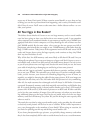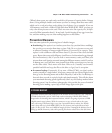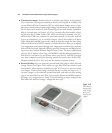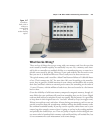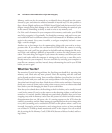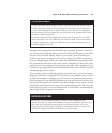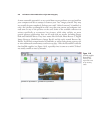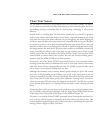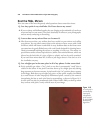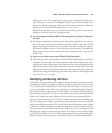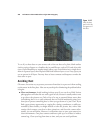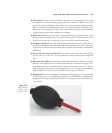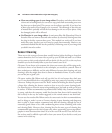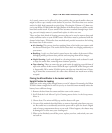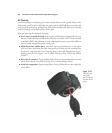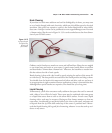
Dust the FAQs, Ma’am
Here are some of the most frequently asked questions about sensor dust issues.
Q. I see tiny specks in my viewfinder. Do I have dust on my sensor?
A. If you see sharp, well-defined specks, they are clinging to the underside of your focus
screen and not on your sensor. They have absolutely no effect on your photographs,
and are merely annoying or distracting.
Q. I can see dust on my mirror. How can I remove it?
A. Like focus-screen dust, any artifacts that have settled on your mirror won’t affect
your photos. You can often remove dust on the mirror or focus screen with a bulb
air blower, which will loosen it and whisk it away. Stubborn dust on the focus screen
can sometimes be gently flicked away with a soft brush designed for cleaning lenses.
I don’t recommend brushing the mirror or touching it in any way. The mirror is a
special front-surface-silvered optical device (unlike conventional mirrors, which are
silvered on the back side of a piece of glass or plastic) and can be easily scratched.
If you can’t blow mirror dust off, it’s best to just forget about it. You can’t see it in
the viewfinder, anyway.
Q. I see a bright spot in the same place in all of my photos. Is that sensor dust?
A. You’ve probably got either a “hot” pixel or one that is permanently “stuck” due to
a defect in the sensor. A hot pixel is one that shows up as a bright spot only during
long exposures as the sensor warms. A pixel stuck in the “on” position always appears
in the image. Both show up as bright red, green, or blue pixels, usually surrounded
by a small cluster of other improperly illuminated pixels, caused by the camera’s
interpolating the hot or stuck pixel into its surroundings, as shown in Figure 14.9.
A stuck pixel can also be permanently dark. Either kind is likely to show up when
they contrast with plain, evenly colored areas of your image.
David Busch’s Nikon D7000 Guide to Digital SLR Photography478
Figure 14.9
A stuck pixel is
surrounded by
improperly
interpolated
pixels created
by the D7000’s
demosaicing
algorithm.



